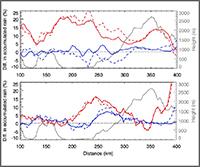Distant Desert Dust Increases Snowpack in California: Local pollution’s influence less impressive on Sierra Nevada Mountains’ precipitation
Overseas dust influences the Sierra Nevada Mountains snowpack far more than home-produced pollution, according to scientists at Pacific Northwest National Laboratory. By modeling two cloud conditions during a field experiment called CalWater 2011, their results showed that dust blown in possibly from Asia and Africa increases snow in winter clouds over California and increases precipitation by 10 to 20 percent. However, local pollution from California cities and the Central Valley exerts a very small impact on snowfall. Further, the local pollution’s influence on rain from warm clouds heavily depends on cloud conditions and the strength of a low level jet caused by mountain blocking that blows parallel to the Sierra Nevada Mountains.
“We used observational data captured in the clouds and on the surface to better understand how cloud ice forms in the presence of dust particles and simulated this process in models,” said Dr. Jiwen Fan, PNNL atmospheric scientist and lead author of the study. “We compared the impact of long-range transported dust and local pollution on cold-season precipitation in contrasting cloud and meteorological conditions.”
The research team led by PNNL’s Dr. Jiwen Fan conducted high-resolution simulations using the Weather Research and Forecasting (WRF) model with a very detailed cloud microphysical model for two winter mixed-phase (liquid and ice) cloud cases. They used ground-based, aircraft and satellite data collected during the CalWater field campaign on February 16 and March 2, 2011. The simulations were highly detailed and computationally expensive. To improve the model representations of ice nucleation processes, they employed a state-of-the-art ice formation representation to connect dust with ice nucleation processes and used field campaign data from PNNL-operated Gulfstream-1 aircraft to validate the simulated clouds.
The largest source of fresh water and irrigation in California is snow melt from the Sierra Nevada Mountains. Regional water resource managers and planners must understand the environmental and climate influences on California’s precipitation and water supply sources. This need propelled the CalWater 2011 field campaign. Understanding the complex factors that impact precipitation and mountain snowpack will help improve regional climate predictions and far-reaching effects on populations and food supply.
Understanding factors that contribute to precipitation and snowpack formation has important implications for hydrologic and regional climate prediction. Suppression of orographic precipitation (rainfall affected by mountains) by anthropogenic aerosols can be a significant problem along the U.S. west coast, where precipitation over the mountains is a major water source for the region. Researchers led by DOE scientists at Pacific Northwest National Laboratory incorporated measurements from the CalWater field campaign, and recent developments in ice nucleation parameterizations to link ice nucleating aerosols with ice crystal formation into a spectral-bin microphysical model coupled with the Weather Research and Forecasting model. Simulating two cloud cases with contrasting meteorology and cloud dynamics, the team found that the dust/biological aerosol layers from long-range transport increase precipitation by 10-20% from the Central Valley to the Sierra Nevada Mountains. Their model results revealed that the effects of local pollution on cloud microphysics and precipitation strongly depend on meteorology, including cloud dynamics and the strength of the Sierra Barrier Jet. This study underscores the importance of the interactions between local pollution, dust and environmental conditions for assessing aerosol effects on cold season precipitation in California.
This study was supported by the California Energy Commission (CEC) and the U.S. Department of Energy (DOE) Office of Science as part of the Regional and Global Climate Modeling program. The G-1 is base-funded by the DOE’s Atmospheric Radiation Measurement (ARM) Climate Research Facility and the deployment of the G-1 during the CalWater campaign was supported by CEC. PNNL Institutional Computing resources were used for the study simulations.

